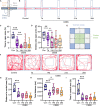The Impacts of Workplace Environment on Coal Miners' Emotion and Cognition Depicted in a Mouse Model
- PMID: 35783230
- PMCID: PMC9245518
- DOI: 10.3389/fnbeh.2022.896545
The Impacts of Workplace Environment on Coal Miners' Emotion and Cognition Depicted in a Mouse Model
Abstract
Most coal mine accidents are caused by the unsafe behavior of employees. Previous studies have shown that there is a significant connection among the working environment, the psychological state of employees, and unsafe behaviors. However, the internal biological mechanism has not been revealed. To explore the physiological and psychological alterations of coal mine workers and the underlying mechanisms that cause unsafe behaviors, the current study established a novel coal mine environment biological simulation (CEBS) model in mice. This model recreated the underground workplace environment facts in coal mines such as temperature, humidity, and noise, and mice were employed to receive these conditioning stresses according to the 8-h work. Animal behavior tests were performed to evaluate the evolution of the mental state including anxiety and depression, as well as the abilities of learning and memory during the 4-week environmental simulation. CEBS mice showed the adaptation process of anxiety from occurrence to stability in the process of environmental simulation, and also suffered from severe depression compared to the control mice. In addition, impaired spatial memory was also implicated in mice after 4-week CEBS. The behavior results of CEBS mice were consistent with the previous psychological investigation of coal workers. In summary, a novel mouse model was established in this study to depict the occurrence of negative emotions and impaired cognition in coal miners by simulating the underground workplace environment, which provided a basis for further exploring the biological mechanism of miners' unsafe behavior.
Keywords: coal mine; cognition; emotion; unsafe behavior; workplace environment.
Copyright © 2022 Li, Wang, Huang, Zhi, Cai, Fang, Yan, Xi and Feng.
Conflict of interest statement
The authors declare that the research was conducted in the absence of any commercial or financial relationships that could be construed as a potential conflict of interest.
Figures




References
-
- Cao Q. G., Yu K., Zhou L. J., Wang L. L., Li C. A. (2019). In-depth research on qualitative simulation of coal miners’ group safety behaviors. Saf. Sci. 113 210–232. 10.1016/j.ssci.2018.11.012 - DOI
-
- Chen H., Qi H., Feng Q. (2013). Characteristics of direct causes and human factors in major gas explosion accidents in Chinese coal mines: case study spanning the years 1980–2010. J. Loss Prev. Process Industr. 26 38–44. 10.1016/j.jlp.2012.09.001 - DOI
LinkOut - more resources
Full Text Sources

